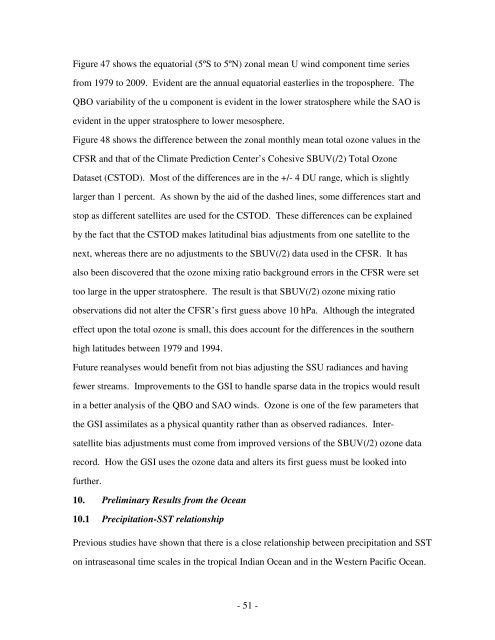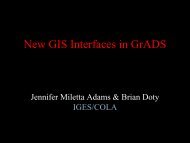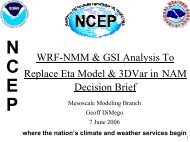The NCEP Climate Forecast System Reanalysis - NOAA National ...
The NCEP Climate Forecast System Reanalysis - NOAA National ...
The NCEP Climate Forecast System Reanalysis - NOAA National ...
Create successful ePaper yourself
Turn your PDF publications into a flip-book with our unique Google optimized e-Paper software.
Figure 47 shows the equatorial (5ºS to 5ºN) zonal mean U wind component time seriesfrom 1979 to 2009. Evident are the annual equatorial easterlies in the troposphere. <strong>The</strong>QBO variability of the u component is evident in the lower stratosphere while the SAO isevident in the upper stratosphere to lower mesosphere.Figure 48 shows the difference between the zonal monthly mean total ozone values in theCFSR and that of the <strong>Climate</strong> Prediction Center’s Cohesive SBUV(/2) Total OzoneDataset (CSTOD). Most of the differences are in the +/- 4 DU range, which is slightlylarger than 1 percent. As shown by the aid of the dashed lines, some differences start andstop as different satellites are used for the CSTOD. <strong>The</strong>se differences can be explainedby the fact that the CSTOD makes latitudinal bias adjustments from one satellite to thenext, whereas there are no adjustments to the SBUV(/2) data used in the CFSR. It hasalso been discovered that the ozone mixing ratio background errors in the CFSR were settoo large in the upper stratosphere. <strong>The</strong> result is that SBUV(/2) ozone mixing ratioobservations did not alter the CFSR’s first guess above 10 hPa. Although the integratedeffect upon the total ozone is small, this does account for the differences in the southernhigh latitudes between 1979 and 1994.Future reanalyses would benefit from not bias adjusting the SSU radiances and havingfewer streams. Improvements to the GSI to handle sparse data in the tropics would resultin a better analysis of the QBO and SAO winds. Ozone is one of the few parameters thatthe GSI assimilates as a physical quantity rather than as observed radiances. Intersatellitebias adjustments must come from improved versions of the SBUV(/2) ozone datarecord. How the GSI uses the ozone data and alters its first guess must be looked intofurther.10. Preliminary Results from the Ocean10.1 Precipitation-SST relationshipPrevious studies have shown that there is a close relationship between precipitation and SSTon intraseasonal time scales in the tropical Indian Ocean and in the Western Pacific Ocean.- 51 -





